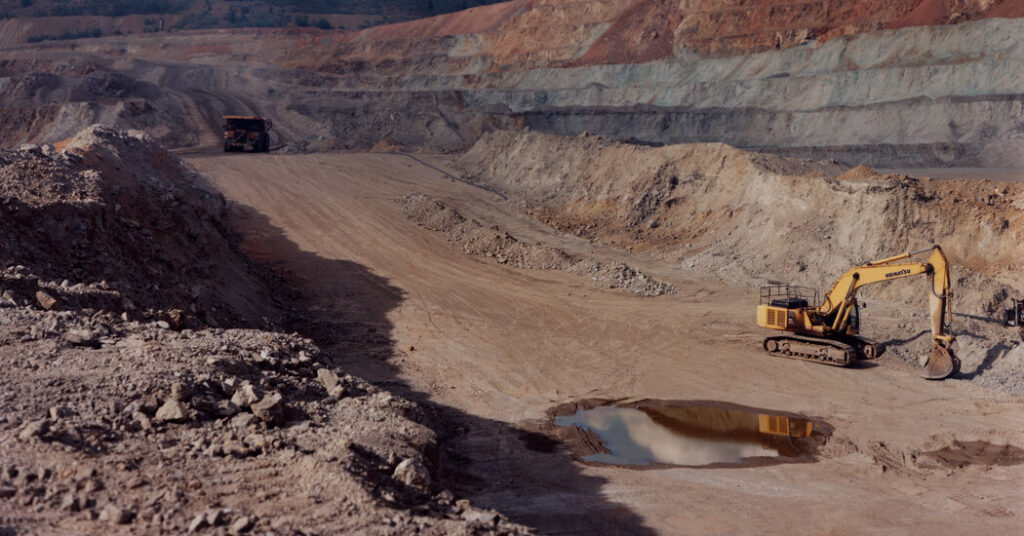There’s a story instructed a few miner who discovered copper cans in his rubbish unload within the early days of mining. Wastewater from copper mining had flowed thru his land, he mentioned, and grew to become metal cans into copper.
The tale may well be apocryphal, however the procedure is actual, and it’s referred to as cementation. Montana Sources, the mining corporate that took over from the Anaconda Copper Corporate, nonetheless makes use of this alchemical trick in a procedure at its Continental Pit mine in Butte, Mont.
Later to the mine is the Berkeley Pit, which is stuffed with 50 billion gallons of a extremely acidic, poisonous brew. Montana Sources pipes liquid from the pit, enabling it to cascade onto piles of scrap iron. The iron turns into copper and is collected for manufacturing.
Age forms to take away metals from H2O had been round a protracted presen, lately the worldwide scramble for metals crucial to production and era advances has given delivery to a untouched week of extraction applied sciences and processes.
One of the crucial mineral-rich assets researchers are all for is wastewater, together with the brine from desalination vegetation, oil and fuel fracking H2O and wastewater from mining. Researchers at Oregon Climate College estimate the brine from desalination vegetation lonely comprises metals valued at about $2.2 trillion.
“Water is the ore body of the 21st century,” mentioned Peter S. Fiske, director of the Nationwide Alliance for H2O Innovation on the Segment of Power’s Lawrence Berkeley Nationwide Lab California. “Technology now is allowing us to pick through the garbage piles of wastewater and pick out the high-value items.”
Analysis at the extraction of infrequent earths, a suite of steel parts, from misuse is usual as the desire for them will increase considerably. Researchers at Indiana Geological and H2O Survey at Indiana College, as an example, are learning the possibility of mining rare earths in coal waste, together with fly ash and coal tailings. And researchers at College of Texas at Austin have created membranes that mimic herbal ones to separate rare earths from waste.
No longer handiest is mining wastewater more cost effective and sooner than establishing untouched mines, it is usually cleaner.
A few of the large waterborne prizes within the pit later to Butte are two bright rare-earth parts (REEs), neodymium and praseodymium. They’re essential for tiny, robust magnets in electrical automobiles, for clinical era and for cover functions, similar to precision-guided missiles and satellites. A unmarried F-35 fighter jet makes use of 900 kilos of rare-earth metals.
“We’re turning a giant liability into something that’s contributing to defense,” mentioned Mark Thompson, vp for environmental affairs at Montana Sources. “There’s some high-level metallurgy going on here. Real egghead stuff.”
This can be a crucial presen for analysis into home manufacturing of infrequent earths. No longer handiest does the US lag some distance in the back of China, however President Trump’s industry battle has spurred China to threaten to additional prohibit rare-earth mineral exports because of the Trump price lists. Professionals with the crucial minerals safety program on the Middle for Strategic and Global Research say the immense hole would permit China to extend its protection features way more temporarily than the US may.
Each Greenland and Ukraine are the focal point of the Trump management’s consideration in immense section since the international locations have vital deposits of infrequent earths.
Mr. Trump additionally simply ordered the federal government to go towards mining immense parts of the sea ground, together with in world waters, for its mineral riches.
There are 17 kinds of metals referred to as infrequent earths, all of which were discovered within the Berkeley Pit. They aren’t infrequent in incidence, however they’re referred to as that as a result of they’re continuously scattered in tiny concentrations.
Uncommon earths are looked after into two types: big and bright. Big infrequent earths — similar to dysprosium, terbium and yttrium — have a better atomic weight and are normally extra infrequent, that means they promote in smaller amounts and are at risk of shortages. Luminous metals, in contrast, have a decrease atomic weight.
Acid mine drainage is a extremely poisonous pollutant created when sulfur-bearing pyrite in rock is uncovered to oxygen and H2O throughout mining. The drainage next oxidizes and creates sulfuric acid and poisons waterways. It’s some of the nation’s largest environmental issues, and tens of 1000’s of lonely mines have infected 12,000 miles of streams.
Alternatively, the acid additionally dissolves zinc, copper, infrequent earths and alternative minerals out of the rock and into the H2O, offering a chance for the suitable era to take away them — which didn’t exist till lately.
Paul Ziemkiewicz, director of the H2O analysis institute at West Virginia College, has researched the pit H2O in Butte for 25 years. He and a crew of researchers from Virginia Tech and L3 Procedure Construction, a chemical engineering company, developed a method to take away crucial metals from acid mine drainage in West Virginia’s coal mines, the similar procedure impaired in Butte. Massive, densely woven plastic luggage are stuffed with a mudlike sludge from the H2O remedy plant. The H2O slowly percolates out, resignation a preconcentrate of about 1 to two p.c infrequent earths that want additional refinement, with chemical processes. The overall step within the patented procedure is an extraction with solvents that creates natural rare-earth parts.
“One of the nice things about acid mine drainage is the concentrates we get are particularly enriched in heavy rare earths,” Dr. Ziemkiewicz mentioned. “The light ones aren’t as valuable.”
The Butte venture is looking forward to contract on a Segment of Protection handover of $75 million to assemble a concentrator, the latter step had to refine the preconcentrate to infrequent earths and start full-scale manufacturing.
Zinc may be abundant within the acid-mine-drainage combine right here and, as it fetches the next worth, is noteceable so as to pay for the method. Nickel and cobalt also are extracted.
Age rare-earth parts are a lot in call for, China produces a majority and manipulates costs to secure them low, which forces out pageant. That’s why the Protection Segment is investment a lot of the paintings on rare-earth parts and alternative metals. The US has only one operational rare-earths mine, in Mountain Pass, Calif., which produces round 15 p.c of the worldwide provide of infrequent earths.
The Berkeley Pit has been a festering sore since 1982, when, the Anaconda Copper Corporate closed the open-pit mine, grew to become off the pumps and let H2O fill it. The H2O is so acidic from acid mine drainage that after tens of thousands of snow geese flew over it on their migration in 2016, many landed at the floor and had been temporarily poisoned. About 3,000 birds died.
The Atlantic Richfield Corporate and Montana Sources are required to regard the pit H2O in continuity to secure it from achieving ranges that would contaminate the section groundwater. (Montana Sources mines the Continental Pit, later to the Berkeley Pit.) The Blank H2O Employment calls for that businesses deal with acid mine drainage, a dear procedure. Including every other stage of remedy to the Horseshoe Bend plant right here is more cost effective than development a untouched one and will offset the prices of remedy and even flip a benefit.
There were dozens of study efforts to disencumber the suspended metals from the H2O. Mr. Thompson displayed a map with strains radiating out from Butte, appearing the place H2O samples have been despatched to investigate amenities around the nation. However the metal-producing procedure that’s occurring now’s the primary one who’s confirmed economical.
Age the riches within the mineral soup right here had been recognized for many years, a strategy to take away them used to be elusive, till Dr. Ziemkiewicz’s crew evolved the untouched mode. He has been generating infrequent earths at two coal mines in West Virginia the place acid mine drainage is a disease. Each and every mine produces 4 heaps of infrequent earths a occasion.
The Berkeley Pit, alternatively, has a far richer focus of infrequent earths in resolution and the next quantity of H2O and is anticipated to manufacture 40 heaps a occasion. Dr. Ziemkiewicz believes this procedure if impaired at alternative mines may sooner or later serve just about all the U.S. imports of rare-earth parts wanted for cover functions, which, he mentioned, recently quantity to about 1,400 heaps.
However call for for infrequent earths may building up through up to 600 p.c within the coming a long time, in accordance to a few estimates.
Within the world attempt to scrub H2O and manufacture crucial minerals, the lab at Lawrence Berkeley researches an array of water-filter-related era, particularly experiments to toughen membranes. It operates a particle accelerator referred to as Complex Luminous Supply, which creates very shining X-ray bright that allows scientists to check numerous membranes on the atomic scale.
The lab has labored with outdoor researchers to manufacture a untouched week of filters, referred to as nanosponges, which can be designed to lure a unmarried goal molecule, similar to lithium.
“It’s an atomic catcher’s mitt,” mentioned Adam Uliana, the important govt of ChemFinity, a Brooklyn corporate learning the importance of nanosponges for cleansing many various kinds of misuse. “It catches one and only one type of metal.”
Lithium, cobalt and magnesium are crucial minerals, along with infrequent earths, that experience attracted really extensive consideration from researchers.
Ion trade, a confirmed methodology for putting off metals and air pollution from H2O, is gaining passion. Lilac Answers, a start-up in Oakland, Calif., has evolved the specialised resin beads had to take away lithium from brine with ion trade and plans to begin its first manufacturing facility on the Superior Salt Pool in Utah.
The corporate’s era pumps brine thru ion trade filters, extracts the mineral and returns the H2O to its supply, a procedure David Snydacker, the corporate’s president, mentioned led to very negligible environmental disturbance. If it proves to paintings at scale, it would revolutionize lithium extraction and shed or do away with the desire for underground mines and at leisure pits.
Magrathea Metals is a start-up in Oakland that makes magnesium ingots from salty brines the leftovers then seawater has been desalinated. The corporate permits the brines to parched, which leaves in the back of magnesium chloride salts. {An electrical} wave — which will make the most of off-peak renewable power — heats the answer and separates the salts from the molten magnesium, which is forged into ingots.
Its important govt, Alex Handover, mentioned this procedure is terribly blank, even though it has but to be impaired to form magnesium at a immense scale. The Segment of Protection has funded a lot of its paintings.
China produces 90 p.c of the arena’s magnesium. The metallic is smelted with one thing referred to as the Pidgeon procedure — . scorching with coal-fired kilns to round 2,000 levels, which is extremely polluting and carbon-intensive. Dr. Fiske expects a bundle extra innovation.
“Three vectors are converging,” he mentioned. “The value of some of these critical materials is going up. The cost of conventional mining and extraction is going up, and the security of international suppliers, especially Russia and China, is going down.”

